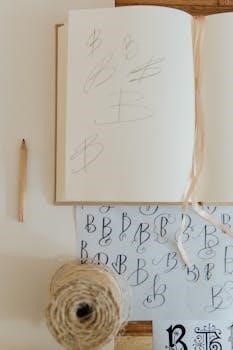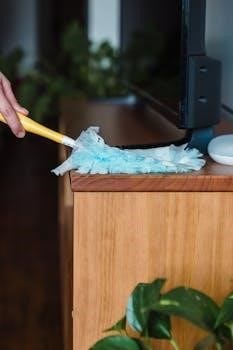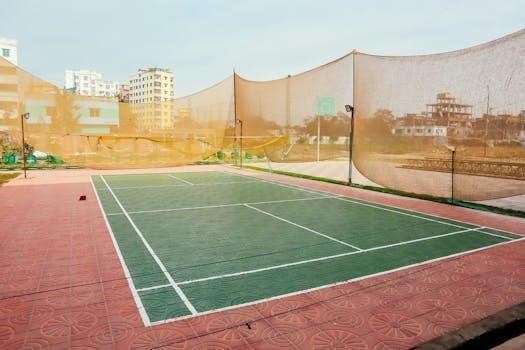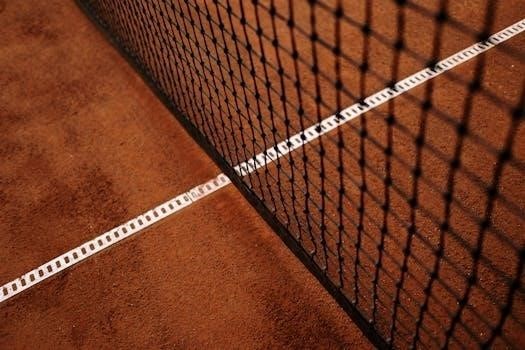
surface area worksheets with answers pdf
Surface Area Worksheets with Answers PDF⁚ An Overview
Surface area worksheets with answers in PDF format offer a comprehensive resource for students and educators. These worksheets cover various shapes, including rectangular prisms, cubes, cylinders, and cones, providing ample practice opportunities.
Surface area is a fundamental concept in geometry that refers to the total area covering the outer surface of a three-dimensional object. Understanding surface area is crucial in various fields, including engineering, architecture, and design. It helps determine the amount of material needed to cover an object or the extent of heat transfer from its surface.
Calculating surface area involves finding the sum of the areas of all the faces or surfaces of the object. For example, the surface area of a cube is the sum of the areas of its six square faces. Similarly, the surface area of a cylinder involves calculating the areas of its two circular bases and the curved lateral surface.
Mastering surface area calculations requires practice with different shapes and formulas. Surface area worksheets provide a structured way to learn and reinforce these skills, offering a variety of problems with varying levels of difficulty.
Importance of Practice Worksheets
Practice worksheets play a vital role in mastering the concept of surface area. They provide students with the opportunity to apply formulas and techniques learned in class, reinforcing their understanding and improving their problem-solving skills. Regular practice helps students become more confident and accurate in calculating surface areas of various shapes.
Worksheets offer a structured approach to learning, presenting problems in a logical sequence that gradually increases in difficulty. This allows students to build their skills progressively, starting with basic shapes and moving on to more complex figures. The availability of answer keys provides immediate feedback, enabling students to identify and correct their mistakes.
Furthermore, practice worksheets cater to different learning styles. Visual learners can benefit from diagrams and illustrations, while kinesthetic learners can engage in hands-on activities involving real objects. By providing a variety of practice opportunities, worksheets help students develop a deeper understanding of surface area and its applications.

Basic Shapes and Surface Area Calculations
This section focuses on understanding the surface area calculations for basic shapes like rectangular prisms and cubes. We will explore formulas and examples to help grasp these fundamental concepts effectively.
Surface Area of Rectangular Prisms
The surface area of a rectangular prism is the total area of all its faces. To calculate it, imagine unfolding the prism into six rectangles. Each rectangle’s area is found by multiplying its length and width. Since opposite faces are congruent, we have three pairs of rectangles with equal areas.
The formula for the surface area (SA) of a rectangular prism is⁚ SA = 2lw + 2lh + 2wh, where l is length, w is width, and h is height. This formula sums the areas of all six faces, ensuring every side is accounted for in the total surface area calculation. Understanding this concept is crucial for solving related problems.
Using worksheets, students can practice applying this formula with various dimensions, reinforcing their understanding and problem-solving skills. These worksheets often include answer keys for immediate feedback, aiding in effective learning.
Example Problems with Answers (Rectangular Prisms)
Let’s explore some example problems to illustrate the concept of finding the surface area of rectangular prisms. Problem 1⁚ A rectangular prism has dimensions length = 8 cm, width = 6 cm, and height = 4 cm. Find its surface area. Solution⁚ Using the formula SA = 2lw + 2lh + 2wh, we have SA = 2(8+ 2(8+ 2(6= 96 + 64 + 48 = 208 cm².
Problem 2⁚ A gift box is in the shape of a rectangular prism with length = 20 inches, width = 14 inches, and height = 10 inches. How much paper is needed to wrap the box? Solution⁚ SA = 2(201+ 2(20+ 2(14= 560 + 400 + 280 = 1240 in².
These examples provide practical applications of the surface area formula, helping students understand how to calculate the surface area of rectangular prisms effectively. Worksheets with similar problems and provided answers offer valuable practice to master this skill.
Surface Area of Cubes
A cube is a special type of rectangular prism where all sides are equal in length. Since all faces of a cube are squares, calculating its surface area is simplified. The formula for the surface area of a cube is SA = 6s², where ‘s’ represents the length of one side of the cube. This formula stems from the fact that a cube has six congruent square faces.
Understanding this concept is fundamental for solving problems involving cubes. By knowing the length of one side, students can easily determine the total surface area by squaring the side length and multiplying by six. Worksheets often include a variety of problems to reinforce this concept, ranging from simple calculations to more complex applications.
Mastering the surface area of cubes is essential for building a strong foundation in geometry.
Example Problems with Answers (Cubes)
To solidify understanding of surface area calculations for cubes, consider the following examples. Example 1⁚ A cube has sides measuring 6 cm each. Find the surface area. Solution⁚ Using the formula SA = 6s², we have SA = 6 * (6 cm)² = 6 * 36 cm² = 216 cm². Example 2⁚ A cube has a side length of 9 inches. Calculate its surface area. Solution⁚ Applying the formula, SA = 6 * (9 in)² = 6 * 81 in² = 486 in².
These examples illustrate the direct application of the formula. Worksheets often provide a range of problems with varying side lengths to challenge students. By working through these problems and checking their answers, students can reinforce their understanding and improve their problem-solving skills.
Consistent practice with example problems is key to mastering surface area calculations for cubes.

Advanced Shapes and Surface Area Calculations
Beyond basic shapes, surface area calculations extend to more complex figures like cylinders and cones. These calculations involve additional formulas and concepts, requiring a deeper understanding of geometric properties and mathematical principles.
Surface Area of Cylinders
Calculating the surface area of a cylinder involves summing the areas of its curved surface and two circular bases. The formula for the curved surface area is 2πrh, where ‘r’ is the radius and ‘h’ is the height. The area of each circular base is πr². Thus, the total surface area is 2πrh + 2πr².
Worksheets often provide practice problems with varying dimensions, requiring students to apply this formula. These exercises may involve finding the surface area given the radius and height, or determining the radius or height when the surface area is known. Remember to use 3.14 for pi when necessary.
Example Problems with Answers (Cylinders)
Example 1⁚ Find the surface area of a cylinder with a radius of 5 cm and a height of 10 cm.
Solution⁚ Using the formula 2πrh + 2πr², we have 2 * 3.14 * 5 * 10 + 2 * 3.14 * 5² = 314 + 157 = 471 cm².

Example 2⁚ A cylinder has a surface area of 269.66 ft² and a height of 4 ft. Find the radius.
Solution⁚ Rearranging the formula, we can solve for ‘r’. Worksheets provide similar problems with detailed step-by-step solutions, aiding students in understanding the concepts and problem-solving techniques. These examples help in mastering cylinder surface area calculations.
Surface Area of Cones
To calculate the surface area of a cone, we need to consider two parts⁚ the base (a circle) and the lateral surface. The formula for the surface area of a cone is given by πr² + πrl, where ‘r’ is the radius of the base and ‘l’ is the slant height; The slant height is the distance from the tip of the cone to any point on the edge of the circular base. Understanding this formula is crucial for solving problems related to cones. Practice worksheets often include various scenarios to help reinforce the concept.
Example Problems with Answers (Cones)
Let’s consider a cone with a radius of 5 cm and a slant height of 10 cm. To find the surface area, we use the formula πr² + πrl; Plugging in the values, we get π(5²)+ π(5)(10) = 25π + 50π = 75π. Using π ≈ 3.14, the surface area is approximately 75 * 3.14 = 235.5 cm². Another example involves a cone with a radius of 3 inches and a slant height of 7 inches. The surface area is π(3²) + π(3)(7) = 9π + 21π = 30π. Using π ≈ 3.14, the surface area is approximately 30 * 3.14 = 94.2 in².

Mixed Shapes and Problem Solving
Exploring surface area calculations of mixed shapes enhances problem-solving skills. Worksheets include combinations of prisms, cylinders, and cones. Students apply formulas and spatial reasoning to find total surface areas, reinforcing their understanding.
Surface Area of Mixed Shapes
Calculating the surface area of mixed shapes involves combining the formulas and techniques used for individual geometric solids. These shapes often consist of two or more basic forms, such as rectangular prisms, cubes, cylinders, and cones, joined together. To find the total surface area, one must identify each component shape, calculate its individual surface area, and then carefully add or subtract areas as needed.
For example, if a shape consists of a cylinder topped with a cone, you would calculate the surface area of the cylinder (excluding the top) and the surface area of the cone (excluding the base) and add them together. It’s essential to account for any overlapping surfaces that are no longer part of the exterior. Mixed shapes worksheets provide valuable practice in applying geometric principles to real-world scenarios, fostering critical thinking and problem-solving skills.
Example Problems with Answers (Mixed Shapes)
Solving surface area problems involving mixed shapes requires a systematic approach. Consider a structure composed of a cube with a pyramid on top. To find the surface area, calculate the area of the five exposed faces of the cube (since one face is covered by the pyramid) and then add the area of the four triangular faces of the pyramid.
Another example might involve a cylinder with a hemisphere on one end. Here, you would calculate the curved surface area of the cylinder, the area of the circular base, and half the surface area of a sphere. Remember to exclude the circular face where the hemisphere connects to the cylinder, as it’s no longer part of the exterior surface. Worksheets with detailed solutions provide step-by-step guidance, helping students understand how to break down complex shapes and apply appropriate formulas.